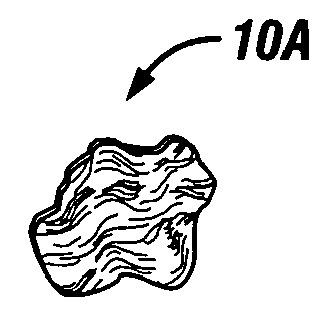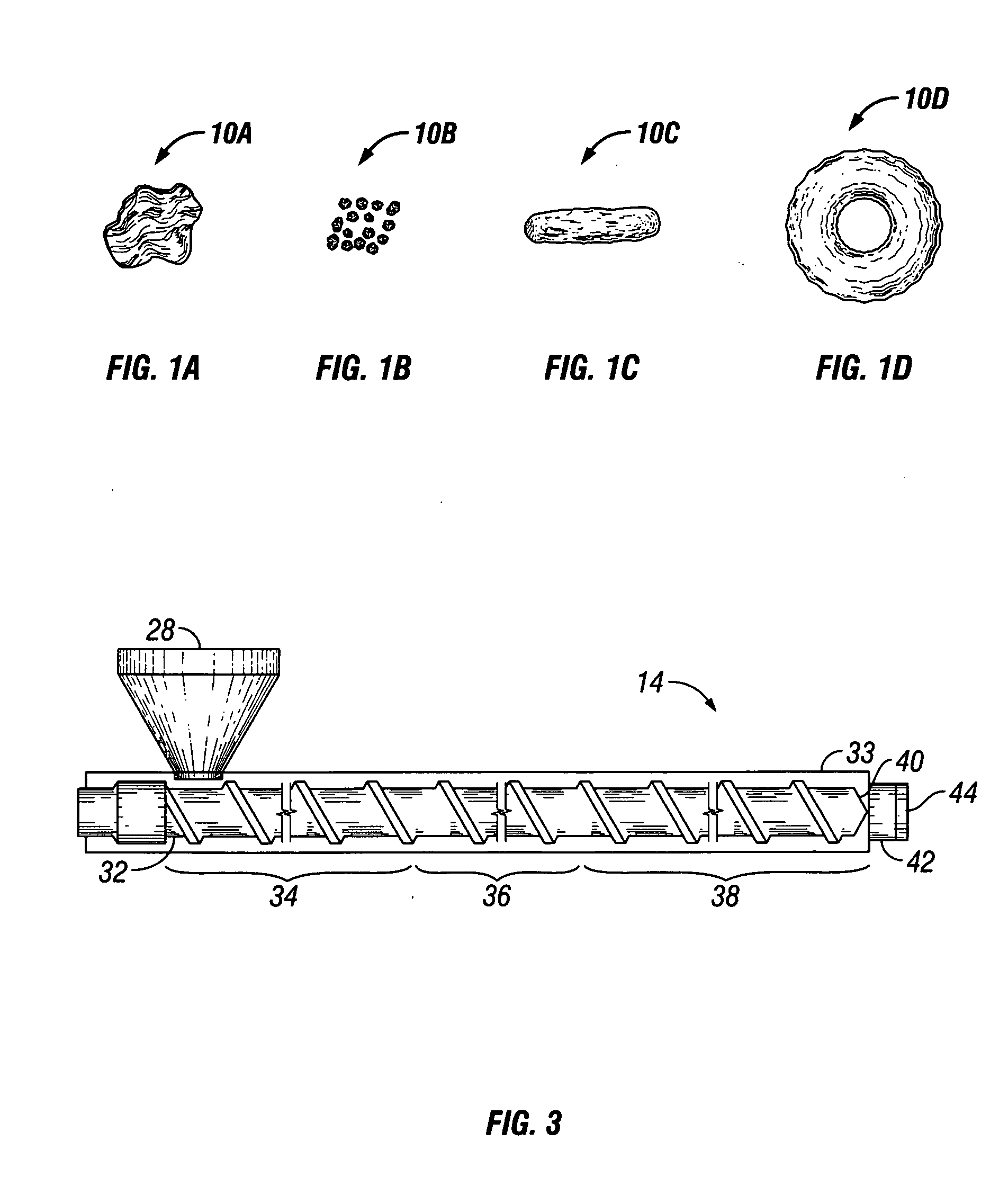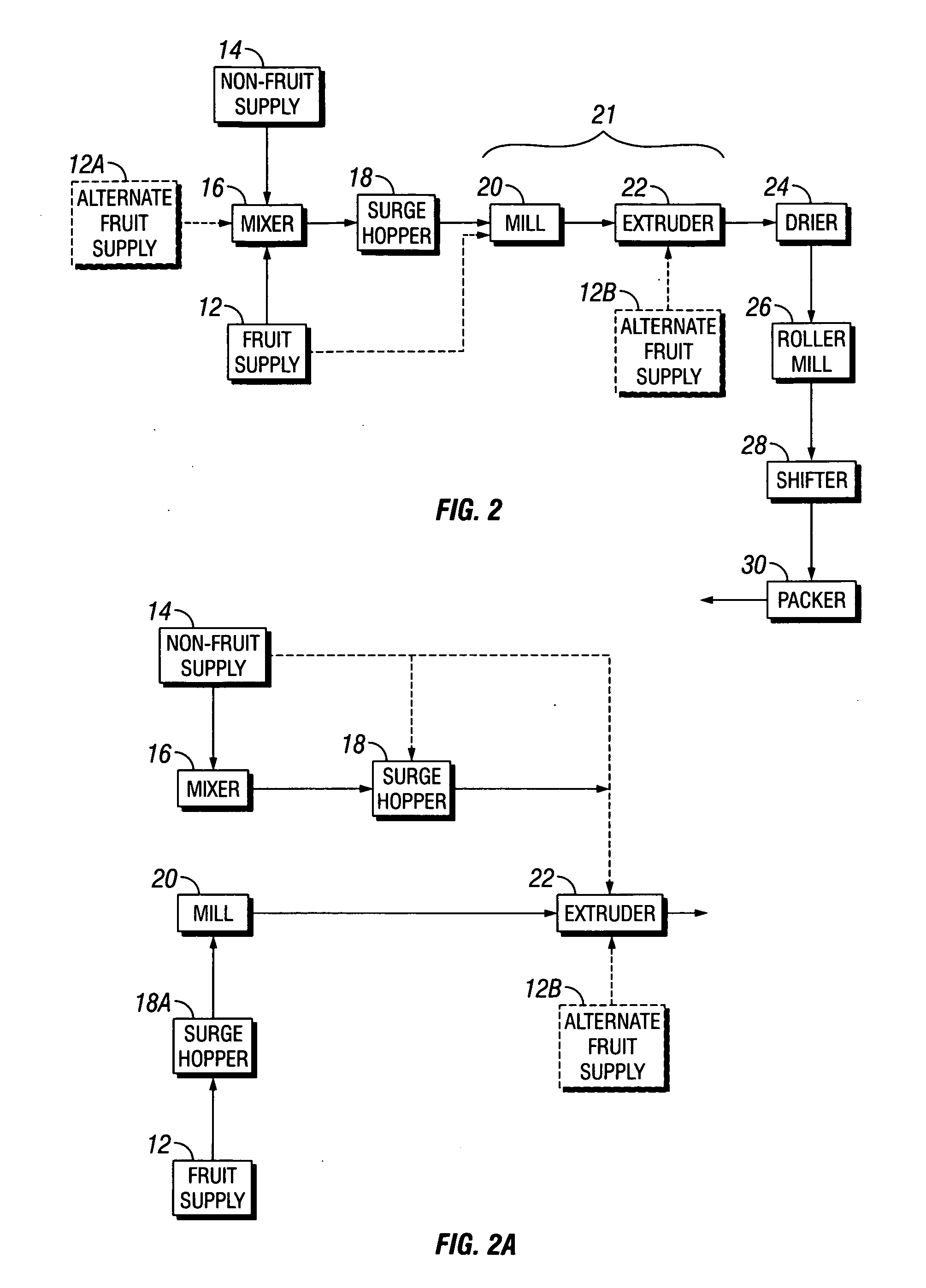Ready-to-eat dry fruit products and process
a ready-to-eat, fruit technology, applied in the field of food products and food processing, can solve the problems of high price, limited to high-margin products or small percentages, and fruit content, and achieve the effects of reducing costs, high moisture content, and high degree of efficiency
- Summary
- Abstract
- Description
- Claims
- Application Information
AI Technical Summary
Benefits of technology
Problems solved by technology
Method used
Image
Examples
example 1
Crunchy Apple Candy, 100% Apple
[0080] Commercially available sweet-apple dices (approximately 29% natural sugars, Fuji variety) were fed at a continuous rate into an Urschel 1700 Comitrol mill equipped with a fine M-style cutting head to reduce the dices to finely divided apple pulp pieces. These flowed down a chute directly into the feed throat of a 5-head single screw extruder equipped with high-pressure screws, a pressure plate and restrictive die openings to increase the extrusion backpressure. No liquids were added; the native apple juice in the dried apples having 26% residual moisture provided adequate moisture for extrusion processing. From in-feed to exit die, the temperatures in the extrusion heads steadily increased from room temperature in the feed section to 130° C. (266° F.) at the die. The extrudate was sliced at the die face into amorphous lumps approximately 1 cm diameter and was conveyed to a forced-air, continuous-tray drier at 82° C. (180° F.) for 60 min. Drying...
example 2
Granular Apple Breakfast Food, 100% Apple
[0081] Three commercial apple sources: dried Granny Smith variety sour apple dices, Fuji variety sweet apple slices, and granular apple fiber, can be mixed in a ribbon blender for 2 minutes at proportions of 50%, 45% and 5%, respectively. The mix was metered into an Urschel 1700 Comitrol mill with a fine M-style cutting head, then directly into the feed section of a single screw extruder described in Example 1. The mix can be processed under the same extrusion conditions and the same drying conditions as in Example 1. The dried product exiting from the drier can be roller-milled and sifted, and the fraction falling through a U.S. #4 Standard Sieve but remaining above a U.S. #8 Standard Sieve retained for finished product packaging. The coarse particles staying on top of the #4 sieve can be recycled to the roller mill for regrinding, and the fines falling through the #8 sieve can be returned to the mixer and reprocessed. The moisture content ...
example 3
Cranberry Puff-Ball Snack
[0082] Commercially available dried cranberry dices (advantageously not sugar infused) can be metered into an Urschel mill equipped with a fine M-style cutting head and fed directly into the pre-conditioner of a single screw extruder. Simultaneously, rice flour can be added at 20% of the cranberry rate, and the two ingredients mixed in the extruder pre-conditioner and fed directly into the feed throat of a single screw extruder, with water added into the first barrel (feed section) to moisten the rice flour, creating inside the extruder a homogeneous fruit dough composed of fruit and rice flour. The extrudate can be cut into approximate spherical puffed extrudate and dried in a forced-air, continuous-tray drier at 82° C. (180° F.) for 20 min to a moisture of 5% maximum. The half-inch diameter spheres are expected to exhibit a crunchy texture having a expected density of about 14 pounds per cubic foot, and a natural light red color and sweet, tart cranberry ...
PUM
 Login to View More
Login to View More Abstract
Description
Claims
Application Information
 Login to View More
Login to View More - R&D
- Intellectual Property
- Life Sciences
- Materials
- Tech Scout
- Unparalleled Data Quality
- Higher Quality Content
- 60% Fewer Hallucinations
Browse by: Latest US Patents, China's latest patents, Technical Efficacy Thesaurus, Application Domain, Technology Topic, Popular Technical Reports.
© 2025 PatSnap. All rights reserved.Legal|Privacy policy|Modern Slavery Act Transparency Statement|Sitemap|About US| Contact US: help@patsnap.com



